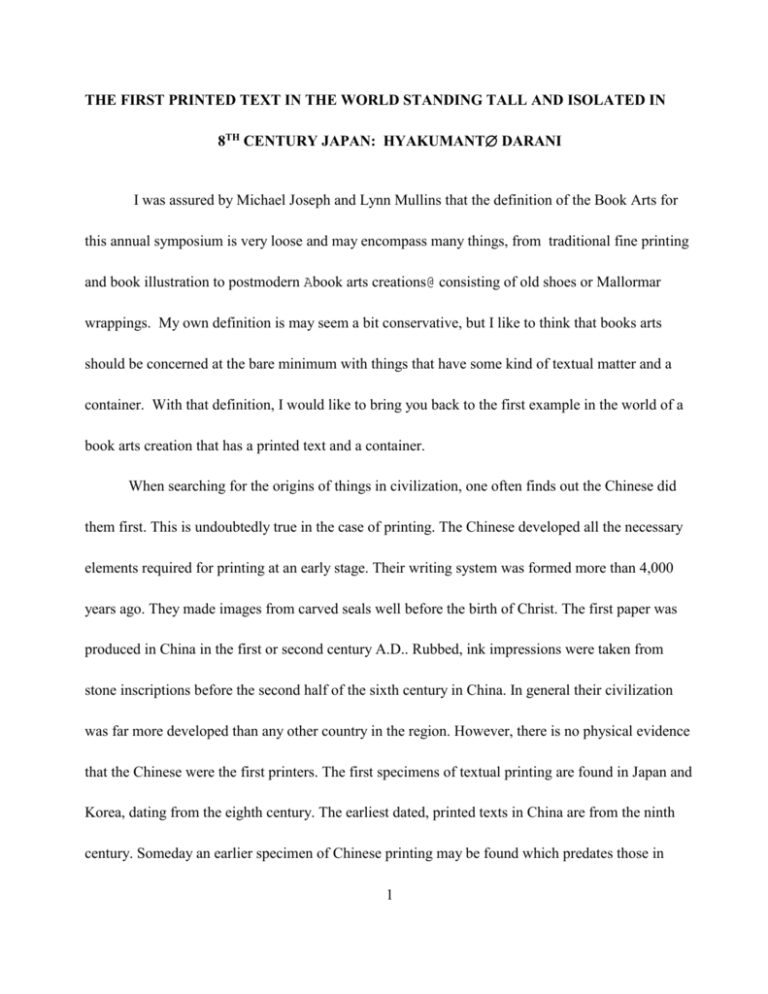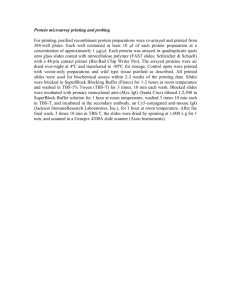THE FIRST PRINTED TEXT IN THE WORLD STANDING TALL AND
advertisement

THE FIRST PRINTED TEXT IN THE WORLD STANDING TALL AND ISOLATED IN 8TH CENTURY JAPAN: HYAKUMANT DARANI I was assured by Michael Joseph and Lynn Mullins that the definition of the Book Arts for this annual symposium is very loose and may encompass many things, from traditional fine printing and book illustration to postmodern Abook arts creations@ consisting of old shoes or Mallormar wrappings. My own definition is may seem a bit conservative, but I like to think that books arts should be concerned at the bare minimum with things that have some kind of textual matter and a container. With that definition, I would like to bring you back to the first example in the world of a book arts creation that has a printed text and a container. When searching for the origins of things in civilization, one often finds out the Chinese did them first. This is undoubtedly true in the case of printing. The Chinese developed all the necessary elements required for printing at an early stage. Their writing system was formed more than 4,000 years ago. They made images from carved seals well before the birth of Christ. The first paper was produced in China in the first or second century A.D.. Rubbed, ink impressions were taken from stone inscriptions before the second half of the sixth century in China. In general their civilization was far more developed than any other country in the region. However, there is no physical evidence that the Chinese were the first printers. The first specimens of textual printing are found in Japan and Korea, dating from the eighth century. The earliest dated, printed texts in China are from the ninth century. Someday an earlier specimen of Chinese printing may be found which predates those in 1 Japan and Korea. But for now, the Japanese and the Koreans have the claim to the earliest printed texts in the world and it is quite certain that these texts were created very near the inception of the printed word. The origin of the printed word in Japan, as well as throughout East Asia, is related to the Chinese writing system and Buddhism. Buddhism was a power force in the development of East Asian civilizations and its texts were written in Chinese. Buddhism was introduced to Japan in the 7th century by Korean monks who brought with them Buddhist texts written in Chinese. The religion and the writing system made a deep impression on the Japanese, who had no writing system before this time. The adoption and adaptation of the Chinese writing system by the Japanese to represent their own language took place over centuries and with great difficulty given the profound difference between the Chinese and Japanese languages. (I give a lecture on this topic and how this it effected the development of Japanese printing, but this is out of scope for today=s talk.) The Japanese texts which are the earliest authenticated printed texts in the world are part of set called the Hyakumant Darani [One Million Pagodas and Darani], consisting of miniature pagodas, each containing one printed Buddhist charm or prayer called dharani in Sanskrit. On a scale rivaling that of modern best sellers, one million charms were printed on thick paper strips, which were rolled up and inserted into the hollow centers of the wooden pagodas. This project was undertaken between 764 A.D. and 770 A.D. by order of Empress Shotoku, after the successful suppression of an insurrection against her Buddhist-oriented court. In 770 the work was completed, 2 and the 1 million pagodas were equally divided and distributed among the 10 leading Buddhist temples in Japan. Thus, each temple received 100,000 Hyakumant darani. ********************* SLIDE 1-- 3 story pagoda for most, 7 story pagoda to mark 10,000 unit, 13 story pagoda for 100, 000th unit ******************** [It was my good fortune when I had my first library job at the University of Illinois at UrbanaChampaign, to find an unprocessed collection of Japanese rare books and manuscripts which the library had purchased from a Japanese literature scholar. Among the items was a Hyakumant darani (3 story pagoda with the printed strip of paper) in excellent condition. The paper strip was still rolled up and placed within the pagoda. It was quite a thrill to actually handle the pagoda and darani.] The pagodas were turned on a lathe and made of hinoki wood. Each copy of the texts were rolled up and inserted into a hole drilled into the top of the pagoda. The spire of the pagoda, also made with a lathe but from cherry wood, plugged the hole so the roll of printed paper would not fall out. ********************** SLIDE 2- typical unit, darani and pagoda darani ********************** 3 An inventory made in 1908 listed all the remaining pagodas in the one temple where they had survived, Hryji in Nara. There were 43,930 or somewhat less than half of its original allotment, but only three hundred were unbroken and complete. The paper strips on which the darani text were printed were made from strong fibers of mulberry and a variety of hemp, and are thick and durable. ********************* SLIDE 3 - Darani text ********************* The strips are of uniform height 5.45 cm. since they all fit into the same sized holes incised in the pagodas, but vary in width because of the different length of the four darani text that were used. (Chinese texts are read from top to bottom, right to left.) In the same 1908 inventory of the Hyakumant Darani at Hryji temple, 1,771 printed texts were listed but by 1937, only one hundred darani remained; the rest, it is assumed, were given away or sold and are now in museums, libraries, and private collections. There were four text of the prayers or darani that were used in the Hyakumant darani from the Muku Jk-ky sutra. They are obviously written with Chinese characters, but the text is now unreadable. Chinese characters are graphic symbols for words, comprising a so-called ideographic or logographic writing system. Every character has a sound and meaning attached to it. The characters here, however, are not used this way. They are used in a non-standardized fashion as 4 purely phonetic graphs to represent the four Sanskrit intoned prayers or dharani. In a sense they are used like letters of the Roman alphabet which form words from the sounds of the letters. But there are only 26 letters in the alphabet and there are a huge number of Chinese characters. To make things even more confusing or destabilizing is the fact that these text represent the sounds of Sanskrit after passing though China, Korea, and ultimately Japan, where each civilization had languages with very different sound systems. But it a sense, it did not matter. These texts were not meant for reading silently or out loud. They were rolled up and inserted into the pagodas, to live out their existence in the darkness of their containers. How this enormous number of copies (remember 1 million) were produced so early in the evolution of East Asian printing has been a source of controversy among historians and bibliographic scholars. If each of the four texts were printed in equal numbers, there were 250,000 copies of each text. Two theories have been proposed, one holding that the texts were printed using wood blocks, the other contending they were made from bronze or copper plates. Wood-block printing would seen to be more likely since later printing was almost exclusively done from wood-blocks in Japan as well as in East Asian in general. Furthermore, there are examples of the use of wood-block in textile design from the seventh and eight centuries. ********************************************************* ********* 5 SLIDE 4 -- CLOTH WITH PRINTED PATTERNS OF BIRDS AND FLOWERS-predating Hyakumanto darani: technique carved design on wood block, applied ink, place cloth on block, apply pressure; large block--21@ by 48@ ********************************************************* ******** Others have argued that wood blocks would not have been sufficiently durable to produce so many copies. A harder surface such as metal plates would be necessary. Those on this side of the argument point out that Japanese craftsmen who produce magnificent bronze sculptures during the seventh and eight century had the skill to produce metal plates. It is speculated that the metal plates would have been made in the following steps: The text was written on thin paper and was pasted face-down on a block of cherry wood and the block was then engraved through the paper. The excess paper was washed off the block. The block was then pressed into a matrix of clay. Then the plates were cast from the clay matrix with molten bronze. Considering the volume of prints that were made (the durability issue), it seems the metal plate theory must have been the process used, even though there is no other example of printing from metal plates in Japan until the 16th century. A question one might have is why were so many copies of these strange texts needed. They were holed up in the pagodas and couldn=t really be read any way. 6 The answer is power and religion. The Buddhist-center court of Empress Shtoku want to commemorate its its victory and sovereignty over rival factions in an impressive way. Even today, we are impressed and a bit awestruck by this massive accomplishment in printing and manufacturing so long ago. The other reason it that the copying the texts and images of Buddhism was considered a religious act. For individuals copying by hand of passages from sutras in elegant calligraphic styles was meritorious. But religious merit could also accrue though reproducing texts and images in mass quantity. So the production of 1million copies of the darani must have been especially praiseworthy. The printing of the texts for the Hyakumanta darani in the late 8th century is a monumental but an isolated development in the history of Japanese printing. There is no mention of printing in historical records again until the latter half of the 10th century and no extant example of dated printed texts until the end of the eleventh century. With such an impressive start, why did it stop? The writing and circulation of texts did flourish during the period when printing seems to have died out. In fact, a rich literary culture flourished from the eighth through the twelfth centuries during the Nara (645-794) and Heian (794-1185) periods. It was carried out, however, in the preferred manuscript form. Several reasons for the neglect of printing and the emphasis on handwriting and calligraphy in Japan during this period have been suggested. First, there was little practical need for printing numerous copies of a work, since only a small circle of people were 7 literate--the courtiers and the clergy. Second, handwriting was highly valued by the Japanese, with the art of calligraphy exalted as a major art form. This magnificent creation in the books arts from 8th century Japan, the Hyakumant darani, gives us the first authenticated printed texts in the world, whose contents are mysterious lost to us, never really meant for us to read. Their elegant containers of lathe-turned pagodas kept the texts in darkness. But the gesture and the accomplishment make us glow within. 8







